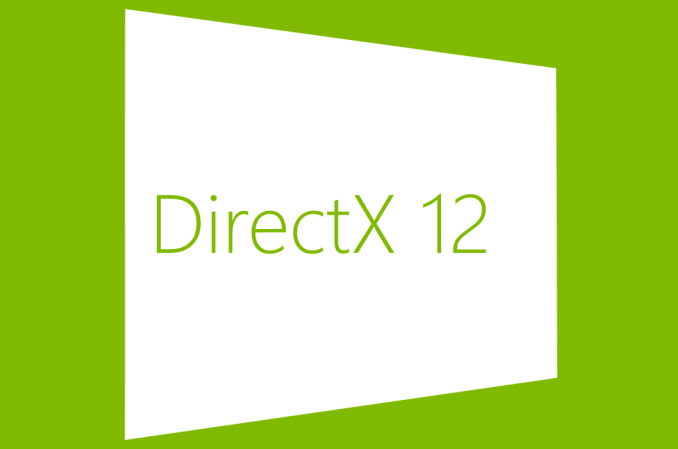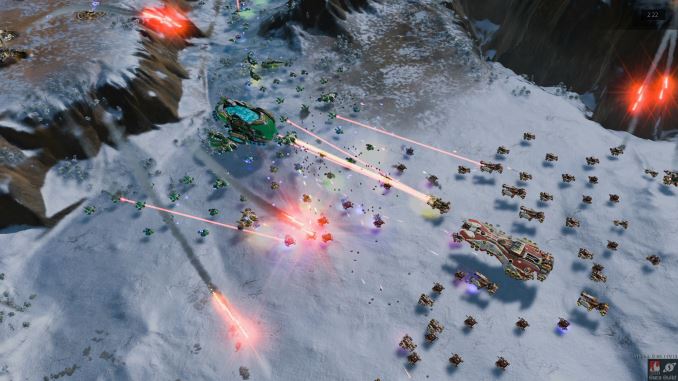Ashes of the Singularity Revisited: A Beta Look at DirectX 12 & Asynchronous Shading
by Daniel Williams & Ryan Smith on February 24, 2016 1:00 PM EST
We’ve been following DirectX 12 for about 2 years now, watching Microsoft’s next-generation low-level graphics API go from an internal development project to a public release. Though harder to use than earlier high-level APIs like DirectX 11, DirectX 12 gives developers more control than ever before, and for those who can tame it, they can unlock performance and develop rendering techniques simply not possible with earlier APIs. Coupled with the CPU bottlenecks of DirectX 11 coming into full view as single-threaded performance increases have slowed and CPUs have increased their core counts instead, and DirectX 12 could not have come at a better time.
Although DirectX 12 was finalized and launched alongside Windows 10 last summer, we’ve continued to keep an eye on the API as the first games are developed against it. As developers need the tools before they can release games, there’s an expected lag period between the launch of Windows 10 and when games using the API are ready for release, and we are finally nearing the end of that lag period. Consequently we’re now getting a better and clearer picture of what to expect with games utilizing DirectX 12 as those games approach their launch.
There are a few games vying for the title of the first major DirectX 12 game, but at this point I think it’s safe to say that the first high profile game to be released will be Ashes of the Singularity. This is due to the fact that the developer, Oxide, has specifically crafted an engine and a game meant to exploit the abilities of the API – large numbers of draw calls, asynchronous compute/shading, and explicit multi-GPU – putting it a step beyond adding DX12 rendering paths to games that were originally designed for DX11. As a result, both the GPU vendors and Microsoft itself have used Ashes and earlier builds of its Nitrous engine to demonstrate the capabilities of the API, and this is something we’ve looked at with both Ashes and the Star Swarm technical demo.
Much like a number of other games these days, Ashes of the Singularity for its part has been in a public beta via Steam early access, while its full, golden release on March 22nd is fast approaching. To that end Oxide and publisher Stardock are gearing up to release the second major beta of the game, and the last beta before the game goes gold. At the same time they’ve invited the press to take a look at the beta and its updated benchmark ahead of tomorrow’s early access release, so today we’ll be taking a second and more comprehensive look at the game.
The first time we poked at Ashes was to investigate an early alpha of the game’s explicit multi-GPU functionality. Though only in a limited form at the time, Oxide demonstrated that they had a basic implementation of DX12 multi-GPU up and running, allowing us to not only pair up similar video cards, but dissimilar cards from opposing vendors, making a combined GeForce + Radeon setup a reality. This early version of Ashes showed a lot of promise for DX12 multi-GPU, and after some additional development it is now finally being released to the public as part of this week’s beta.
Since that release Oxide has also been at work both cleaning up the code to prepare it for release, and implementing even more DX12 functionality. The latest beta adds greatly improved support another one of DX12’s powerhouse features: asynchronous shading/computing. By taking advantage of DX12’s lower-level access, games and applications can directly interface with the various execution queues on a GPU, scheduling work on each queue and having it executed independently. Async shading is another one of DX12’s optimization features, allowing for certain tasks to be completed in less time (lower throughput latency) and/or to better utilize all of a GPU’s massive arrays of shader ALUs.
Between its new functionality, updated graphical effects, and a significant amount of optimization work since the last beta, the latest beta for Ashes gives us quite a bit to take a look at today, so let’s get started.












153 Comments
View All Comments
Koenig168 - Wednesday, February 24, 2016 - link
There is a brief mention of GTX 680 2GB "CPU memory limitations". I take it you mean "VRAM memory limitations". It would be interesting to know if this can be overcome by DX12 memory stacking, either a pair of GTX 680s or the GTX 690.Ryan Smith - Wednesday, February 24, 2016 - link
That was meant to be "GPU memory limitations", thanks for the catch.B3an - Wednesday, February 24, 2016 - link
Why is Beta 2 still not available on Steam? Have the media got early access? At the time of posting this there's still only Beta 1 available.Ryan Smith - Wednesday, February 24, 2016 - link
It's out to the public tomorrow.hemipepsis5p - Wednesday, February 24, 2016 - link
Hey, so I'm confused by the mixed GPU testing. I thought that both cards had to be the same in order to run them in SLI/Crossfire? How did they test a Fury X + 980Ti?Ext3h - Wednesday, February 24, 2016 - link
That's no longer the case with DX12. It used to be like this with DX11 and earlier versions, when the driver decided if/how to split the workload onto multiple GPUs, but with DX12 that choice is now up to the application.So if the developer chooses to support asymmetric configurations, even cross vendor or exotic combinations like Intel IGP + AMD dGPU, then it can be made to work.
anubis44 - Thursday, February 25, 2016 - link
I'm willing to bet that nVidia's Maxwell cards can't use DX12's async compute at all, and they're falling back to the DX11 code path, even when you 'enable' DX12 for them.Ext3h - Thursday, February 25, 2016 - link
You loose that bet.The asynchronous compute term only defines how tasks are synchronized against each other, whereby the "asynchronous" term only states tasks won't block while waiting for each other. The default of doing that in software, in order to create a sequential schedule, is perfectly legit and fulfills the specification in whole.
Hardware support isn't required for this feature at all, even though you *can* optionally use hardware to perform much better than the software solution. Parallel execution does require hardware support and can bring an huge performance boost, but "asynchronous compute" does not specify that parallel execution would be required.
BradGrenz - Thursday, February 25, 2016 - link
The whole point of async compute is to take advantage of parallel execution. It doesn't matter what nVidia's drivers tell an application, if it accepts these commands but is forced to reorder them for serial execution because the hardware can do nothing else then it doesn't really support the technology at all. It's be like claiming support for texture compression even though your driver has to decompress every texture to an uncompressed format before the GPU can read it. It doesn't matter if the application thinks compressed textures are being used if the hardware actually provides none of the benefits the technology intended (in this case more/larger textures in a given amount of VRAM, and in the case of async compute, more efficient utilization of shader ALUs).Sajin - Thursday, February 25, 2016 - link
"Update 02/24: NVIDIA sent a note over this afternoon letting us know that asynchornous shading is not enabled in their current drivers, hence the performance we are seeing here. Unfortunately they are not providing an ETA for when this feature will be enabled."Source: http://www.anandtech.com/show/10067/ashes-of-the-s...